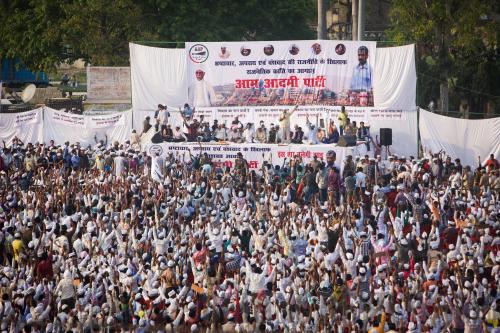|
 |
|
CAMPAIGN HUSTLE: Supporters gather at a rally of the Aam Aadmi Party in Varanasi, north India's Uttar Pradesh, on March 25 (ZHENG HUANSONG) |

The longest election in India's history will take place over nine phases from April 7 to May 12 as 815 million eligible voters cast their ballots. Having prepared for the campaign years in advance, Indian political parties will vie for power in a contest that will draw international attention to India's domestic and foreign policies in the coming five years. Major changes may be in store as the nation battles a host of pressing challenges, but many fundamental features of Indian political life will remain unchanged.
Changing political pattern
Currently, there are two major national-level political powerhouses in India: the incumbent Indian National Congress (INC)-led United Progressive Alliance and the Hindu-nationalist Bharatiya Janata Party (BJP)-led National Democratic Alliance. Starting in the 1970s, Indian politics bid farewell to the one-party dominance of the INC and entered an era of multi-party coalition rule, mainly composed of the two alliances.
However, recent polls hint at an impending shake-up of India's political pattern, with the BJP winning out and a third force increasingly asserting its growing influence. India's mainstream newspaper The Indian Express recently forecasted that the BJP alone will win 245 seats in the coming election. The share of the BJP alliance will easily exceed 272 seats, which are required for a majority in the 543-seat lower house. The seats of the INC alliance are likely to total only 79, significantly lower than the lowest ever seats acquired by the INC alone—114 in 1999.
While the BJP and the INC continue their ups and downs, a more compelling story is that of the sudden rise of a third force in Indian politics. In the 2013 Delhi legislative assembly election, the year-old Aam Aadmi Party (AAP) surprisingly emerged as the second largest party of the Delhi local parliament and formed a minority government replacing the INC, which had ruled the city over the past 15 years. At present, AAP leader Arvind Kejriwal has already resigned from the post of the Delhi chief minister, devoting himself to the national campaign behind the potential new dark horse of the general election.
The possible change in India's political pattern and reshuffle of political forces have several motivating factors, chief among which are inadequate economic growth, severe corruption and anemic reform caused by the poor governance of the INC in the past five years.
Under the impact of the U.S. and European economic crisis, India's economy has lost its prior vigor and slowed drastically since 2009. Particularly since 2011, it has seen a notable drop in its growth and high inflation, foreshadowing an era of stagnation. Meanwhile, the economy has also seen a coexisting fiscal and trade deficit as well as a rapid drop in the exchange rate of its currency. Even the normally optimistic Western media have expressed doubts, declaring, "Farewell to the Indian miracle."
Rife corruption cases in the past several years have precipitated a dramatic loss of public support for the ruling INC. If the INC was high-spirited and vigorous when it won the general election in 2004, its repeat victory in 2009 coincided with a fall to a vested interest group burdened with corruption. Corruption allegations against the Organizing Committee of the 2010 Commonwealth Games, the 2010 mobile license scandal and the 2012 coal allocation scam comprised a damaging string of public scandals. A wave of unprecedented anti-corruption protests have swept India in the past two years, aggravating people's distrust of the INC, as evidenced by the party's provincial election losses.
| 